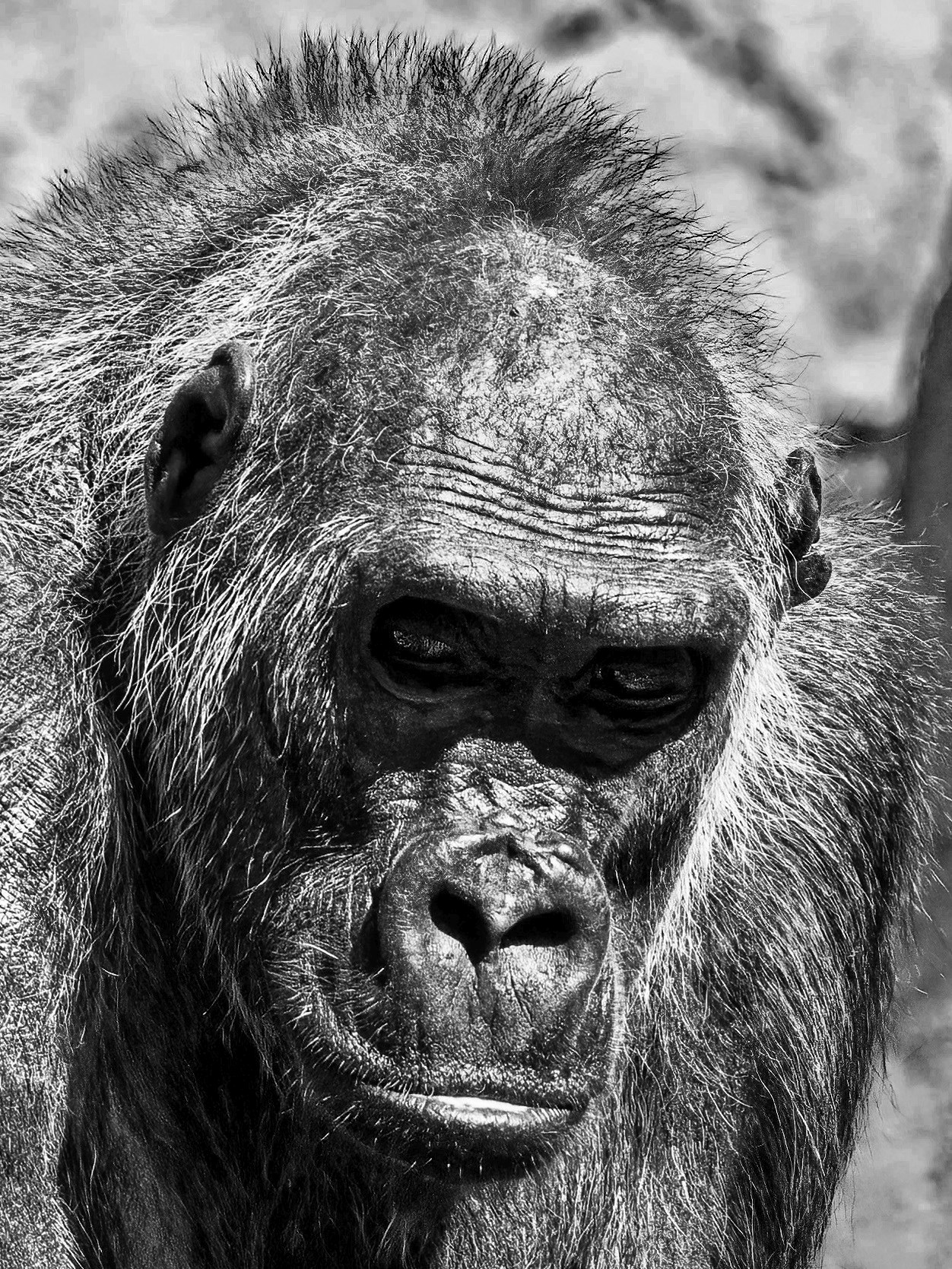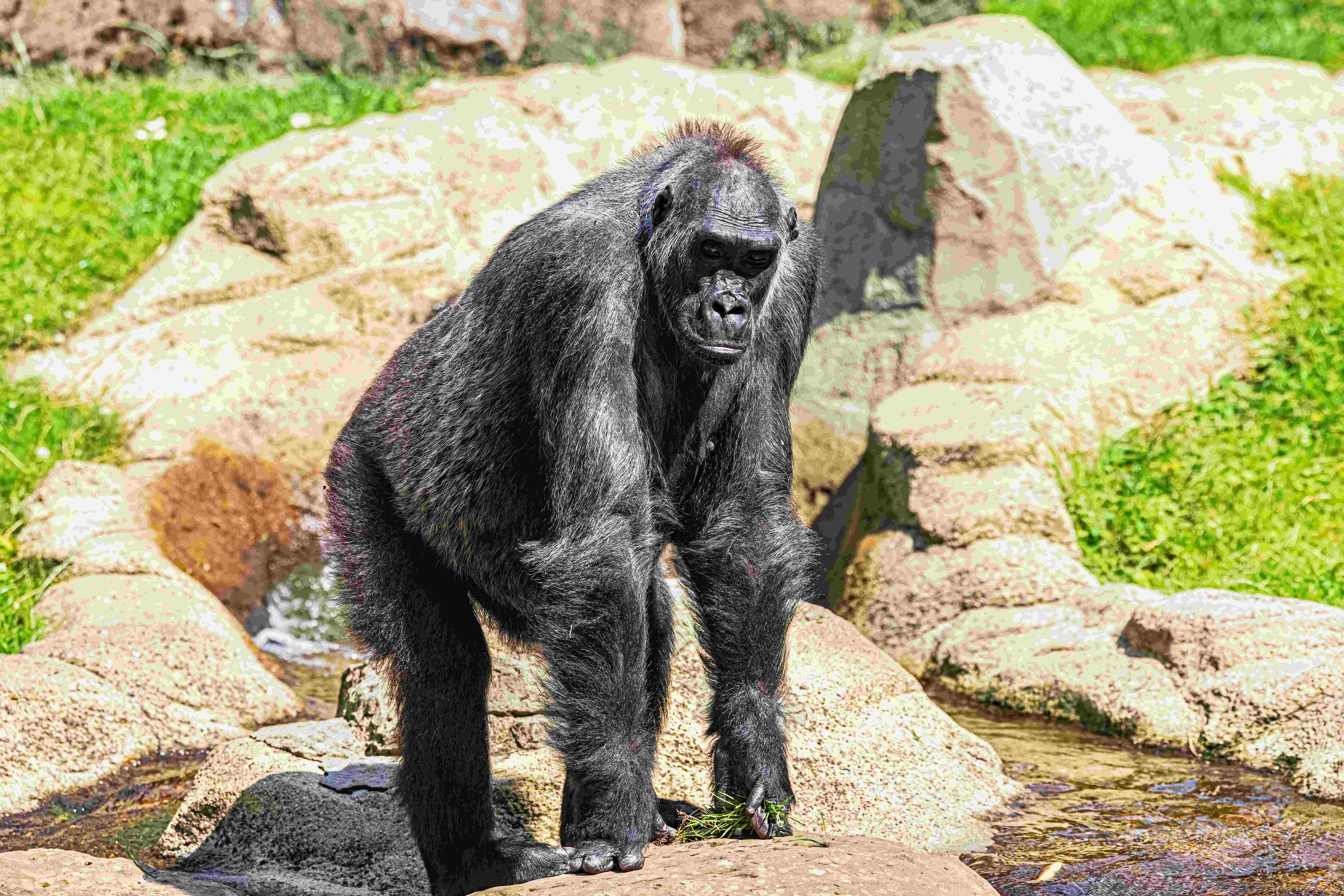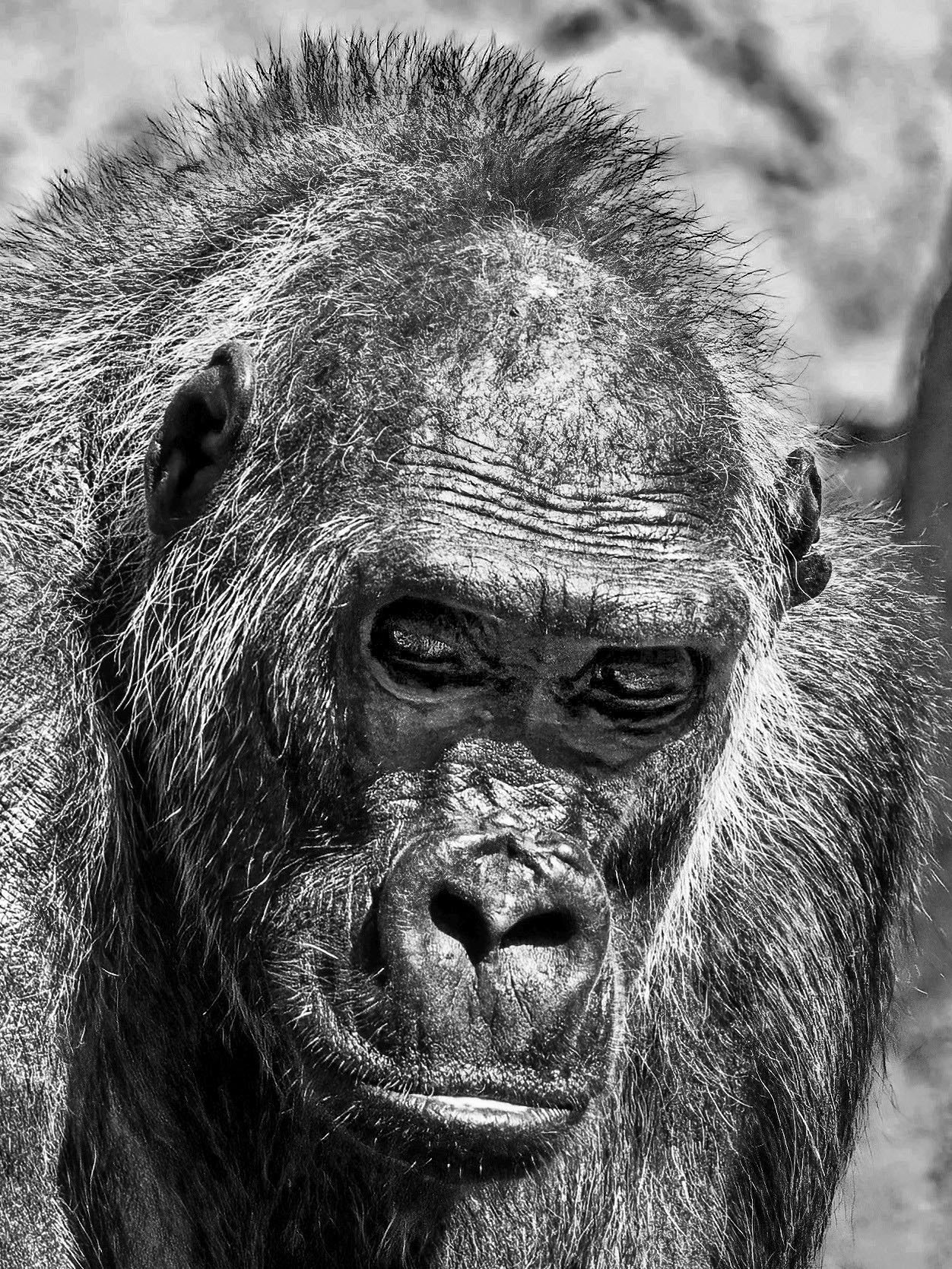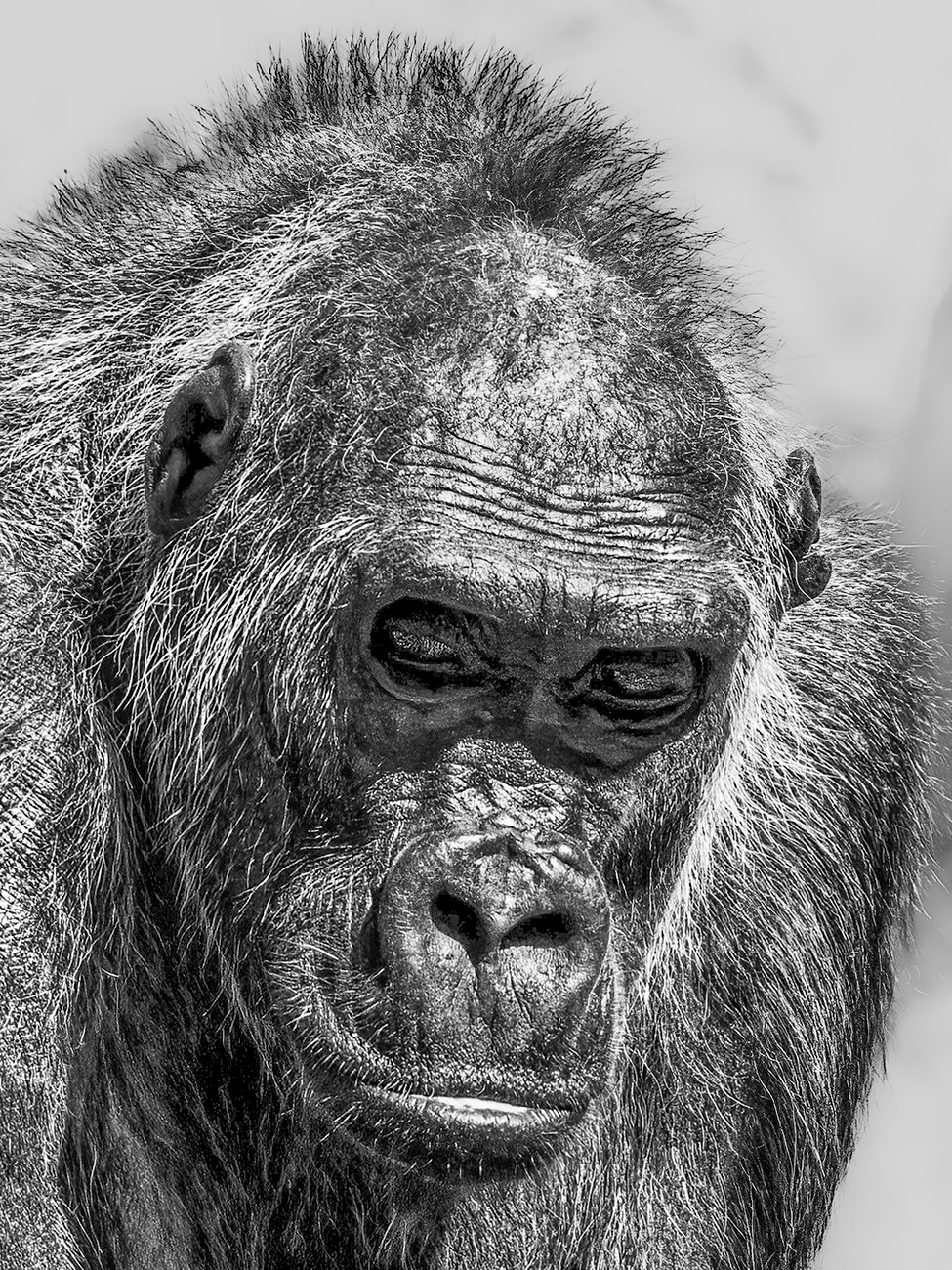Peter Hornbostel
About the Image(s)
We recently visited the Zoo in Hanover, Germany. I intended to make a monochrome picture of a Gorilla. I thought my Canon 70-200mm RF lens would be sufficient with my Canon R5 camera. But the distance was too great to get my desired image. So, I took my best image, one where the Gorilla looked towards the camera. My plan was to get the eyes a little bit lighter, but the sun and the shadows were very strong this day. Nevertheless, I’m happy with the result. I intend to make a new attempt on my next visit.
This round’s discussion is now closed!
8 comments posted
That is a tricky exposure in bright sun, Peter. You captured the detail, but the eyes need help. My suggestion would be the object selection on LR/PS for detail masking and then increase the exposure of the dark area. A quick (imperfect) 3 minute edit is attached to indicate possibilities. You could perfect it to your own tastes.
Posted: 07/08/2024 03:37:40
Posted: 07/08/2024 03:37:40
Thank you Jim. I have already tried to lighten the eyes. I have had a similar result as yours but this would destroy the eye structure. The lens has been to short to take more information into the dark parts. I will try it with a new lens in two months. Hope, I can present a better result! Posted: 07/08/2024 06:15:15
Yes, this is a tricky high contrast situation. I would add that this is somewhat often true to some extent for a majority of outdoor shots, unless it's a cloudy day. The way I tend to naturally remedy this is to most often push up the shadows and diminish the highlights on the image as a whole. I occasionally up the blacks but that most often degrades the image quality. More often I may even accentuate the black a little. Negative contrast also lightens the dark areas of the image and sometimes works.
I then tried selecting the shadows around the eyes with a Luminance range mask in Lightroom from which I subtracted the areas not directly around the eye with a brush. As you noticed, I also find that you can only do very subtle changes in dark areas if you want to keep it natural looking. I only sharpened and reduced noise with this selection, essentially. Upping the shadows and diminishing the highlights on the image as a whole is what worked best for me. I also selected the subject and then created a reverse selection to get the background and lowered the texture and clarity on it. I also lowered the highlights just a bit.
Posted: 07/10/2024 19:56:13
I then tried selecting the shadows around the eyes with a Luminance range mask in Lightroom from which I subtracted the areas not directly around the eye with a brush. As you noticed, I also find that you can only do very subtle changes in dark areas if you want to keep it natural looking. I only sharpened and reduced noise with this selection, essentially. Upping the shadows and diminishing the highlights on the image as a whole is what worked best for me. I also selected the subject and then created a reverse selection to get the background and lowered the texture and clarity on it. I also lowered the highlights just a bit.
Posted: 07/10/2024 19:56:13
Hi Christian,
Thank you for your contribution. It shows one thing above all: my knowledge about Photoshop (I do not use Lightroom) is rudimentary. More than working with tools, a photographer should take care about the situation with the camera, ha! I didn't recognized, that the shutter speed was about 1/8000 instead of 1/800. This pushed the ISO to 3200. All in all too short, to pick up detail information for the picture. First, 200mm are too short for the distance - 300mm will do it better. In a couple of weeks I hopefulla receive my new 200-800mm lens. Second, even on a sunny day a shutter time of 1/400 upto the max of 1/800 should be sufficant for this object moving slow or even rest still. Third, wait, until he's looking straight into the camera. This will hinder, that the eyelashes cover the eyes and destroy a structure while lighten up the dark parts. What does a photographer do in those situations? Try it anew ... I will show a result then. Posted: 07/11/2024 01:36:19
Thank you for your contribution. It shows one thing above all: my knowledge about Photoshop (I do not use Lightroom) is rudimentary. More than working with tools, a photographer should take care about the situation with the camera, ha! I didn't recognized, that the shutter speed was about 1/8000 instead of 1/800. This pushed the ISO to 3200. All in all too short, to pick up detail information for the picture. First, 200mm are too short for the distance - 300mm will do it better. In a couple of weeks I hopefulla receive my new 200-800mm lens. Second, even on a sunny day a shutter time of 1/400 upto the max of 1/800 should be sufficant for this object moving slow or even rest still. Third, wait, until he's looking straight into the camera. This will hinder, that the eyelashes cover the eyes and destroy a structure while lighten up the dark parts. What does a photographer do in those situations? Try it anew ... I will show a result then. Posted: 07/11/2024 01:36:19
I like your composition. Your cropped image is much more interesting than the original. And, I agree that the area around the eyes should be lightened as has already been suggested. Posted: 07/21/2024 11:24:16
Overall, I really like this. I can't add much to what the others have contributed, but I really like where you were going with this. One possible thing to try when dealing with harsh light is to bracket exposure. Have one normal and one 1-2 stops over and layer in the lighter bits in post. If the gorilla was moving quickly that wouldn't work but if he's moving slowly you can often get away with it. Otherwise, Christian's excellent tutorial is the way to go. Posted: 07/24/2024 15:14:52
Jim, Henry, thank you too for your comments. I really should make some further steps in photoshop - on the other hand there is still room for more in photography. There are things to be done.
By the way: Next time I will take "my answer" with me: new lens 200-800 mm Canon. Light enough to be carried around and making precise photos. 200mm were definitely too short and 800 mm with the 400mm 2.8 plus extender to heavy for a day in the zoo. Next time in september! Posted: 07/25/2024 01:26:01
By the way: Next time I will take "my answer" with me: new lens 200-800 mm Canon. Light enough to be carried around and making precise photos. 200mm were definitely too short and 800 mm with the 400mm 2.8 plus extender to heavy for a day in the zoo. Next time in september! Posted: 07/25/2024 01:26:01
You caught the gorilla posing nicely for you. There's not much I can add to the comments already given. When an image doesn't quite make it, look at it with a very critical eye to see what did or did NOT work. The "hard" part is remembering this info! I did notice some magenta and purple colors in parts of its fur in the original image. Not sure why that would happen. Posted: 07/28/2024 01:07:03



